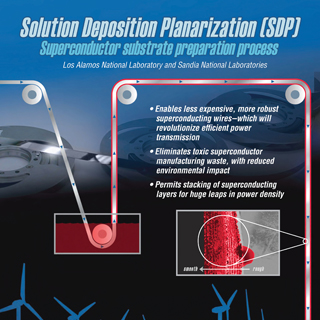
Short notice to press time led to an abbreviated mention in the July 16 Lab News of Sandia’s fifth R&D100 Award, a joint achievement of Sandia and Los Alamos National Laboratory (LANL) of an improved superconducting wire manufacturing process.
The advance seeks to reduce production costs of superconducting wire while supporting significantly higher power densities. To do this, the crystalline structure of the superconductor must be aligned over long distances.
Four other awards won by Sandia were described at some length .
For the fifth award, the Sandia team of Cynthia Edney (1816), Jon Ihlefeld (1816), and Paul Clem (1815) developed the chemistry, process conditions, and optimization of a reel-to-reel method of Ångstrom-scale planarization coating, while LANL developed a scale-up method and subsequent processes for the ion-beam-deposited template and superconductor layers.
The winning submission, submitted by LANL and titled “Solution Deposition Planarization,” was “a team effort that relied on both labs’ strengths: Sandia’s Materials and Process Sciences Center 1800 and LANL’s Superconducting Technologies Center Research Park,” Paul says.
The SDP process prepares atomically smooth superconducting substrates by dip-coating rough metal tapes in a liquid precursor mixture and then annealing the coating to reduce roughness. The planarized coating then enables kilometer-length deposition of ion-beam textured templates and biaxially oriented superconductor films at high speeds and low production cost. The SDP process eliminates toxic waste and three expensive processing steps to achieve high-performance superconducting wires.
Two industrial partners are said to be implementing production of the low-cost superconducting wire, expected to make more efficient and compact large industrial electric motors, lighter and smaller megawatt-scale wind turbines, and long-length DC energy transmission lines with nearly zero energy loss.